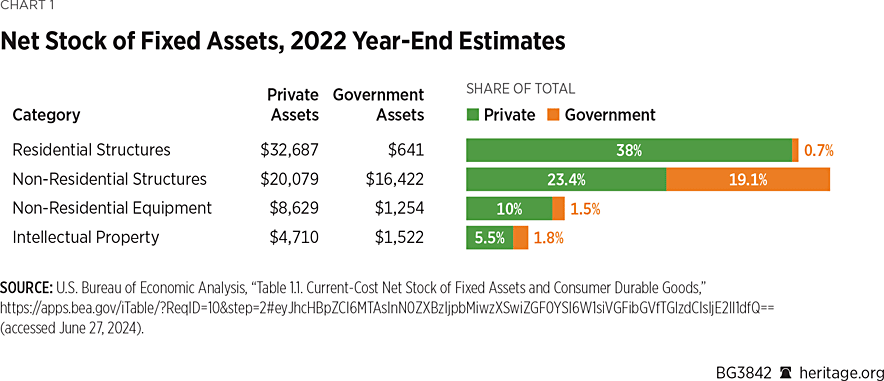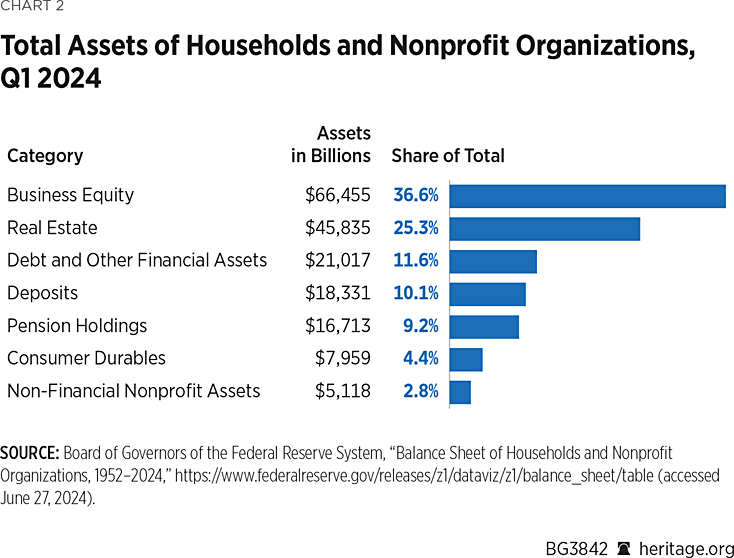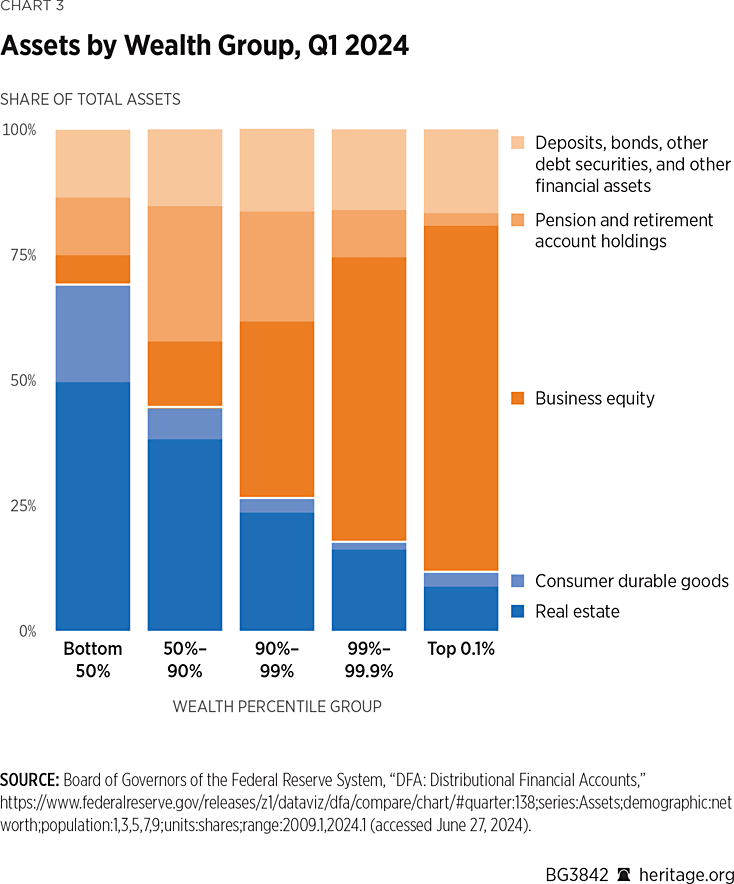A key feature of economic debate comes down to one word: wealth. For many, wealth conjures images of piles of gold bars in a vault, sterile cash in the bank, or the yachts and Rolexes of the wealthy. Which is to say that common conversation about wealth treats it as a collection of idle idols. In truth, these types of non-productive assets represent a small portion of the wealth of any society or of most wealthy people. The vast majority of wealth is the opposite—a collection of productive tools that are used, mostly by businesses, to generate prosperity.
Today the country stands at a crossroads. Over the past several decades, there has been a growing sense of economic malaise. Though this malaise has been brought on by the tremendous expansion of the federal government and its burdens on the American public, the policy debates often misassign blame. Many policymakers have turned against the process of wealth creation that made America the most prosperous country on Earth. The U.S. economy rests on a delicate balance of workers, innovators, and entrepreneurs working together—with the aid and perspective of investors—to generate wealth and useful products. These products also free people’s time from tedious labor so they can lead purpose-filled lives.
If America is to reverse this decline and restore economic dynamism, the anti-wealth sentiment must be quashed. Policymakers must defend the right of innovators and entrepreneurs to generate wealth and use it to build the future.
Overwhelmingly, the wealth of America consists of the productive assets that its citizens possess. It is not the case that money is tied up in these assets, but rather, the assets are themselves wealth. These assets include factory equipment, farm tractors, and office buildings. Wealth also includes financial assets that represent the extra value of bringing these physical assets together in a way that produces the goods and services that people enjoy—adding in the intangible value of the work of innovators and entrepreneurs.
This kind of wealth is the foundation of all economic production. Wealth is both a result of prior innovations and a driver of future discoveries that will unburden Americans of the scarcities of today. Wealth, forcibly removed from the context where it is productively utilized ceases to retain its full value. As such, policies designed to redistribute wealth unavoidably have the effect of destroying it.
Ultimately, the assets that comprise wealth are the tools that workers use to produce the products that enrich and extend everyone’s lives and afford people the free time to spend with their families and in their communities.
Tragically, through a combination of willful ignorance and misguided action, sometimes borne of envy, many policymakers and policy debates are squarely focused on destroying these engines of innovation and prosperity: the national wealth and the productive assets it represents.
The aim of this Backgrounder is to lay out the different forms of wealth, how their use and generation is essential to the creation of a prosperous society, and how policies that interfere in this process will lead to poverty and stagnation. Understanding what wealth truly is and how it is used is an integral part of understanding how the economy functions.
Price Signals and Yardsticks
The economy has one purpose: to produce the goods and services that households need and desire. The process of production requires the basic ingredients of labor and capital (productive assets). Additionally, it needs one more animating agent: knowledge.
One of the true miracles of any economy is the coordination of millions of people and businesses to assemble vast and complex production chains all leading to the creation of useful and easily accessible products. Though money is often thought of as the essence of wealth, it is not. It is a yardstick. Money brings an ordered standardization to the process of millions of people making transactions and coordinating their work; it is a way of making the chaotic organized and measurable.
The crucial pieces of knowledge required to pull off the miracle of economic production are found in prices. These price signals illuminate the true physical cost of production and distribution of a product and the value of such a product to prospective consumers.
The classic 1958 case study, “I, Pencil,” illuminates the complexity of economic production.REF “I, Pencil” demonstrates how the work of thousands of people from across the globe must come together to produce even a humble pencil.
The use of a currency to record information provides a common language to make economics possible. In the same way that standardizing the English language, the length of a mile, or the weight of a pound is essential, so, too, is the ability to convert value into dollar terms. It is a way to quickly compare economic trade-offs and to communicate what is worthwhile and what is not. In the same way that writing can capture a story or an emotion, prices and other dollarized values provide a useful, albeit imperfect, way of capturing the information flowing through millions of economic interactions.
In this way, one sees the real use of money—to standardize the measurement of every aspect of an economy, facilitate the exchange of resources, and coordinate productive efforts.
Capital Stock: The Foundation of an Economy
Labor requires a worker’s time, effort, and knowledge. Capital, on the other hand, is any tool that workers use as a multiplier of their labor. It would be hard to make a pizza without an oven or to build a modern skyscraper without a powered crane—these are just two of the many examples of how productive assets (tools) multiply the value of people’s labor, and therefore greatly increase the wages workers draw from their work.
Capital can be anything from a hammer or a blast furnace in a steel mill to a truck that delivers Amazon packages to people’s homes. In fact, a person’s home itself is a form of capital, providing the owner with a reliable supply of shelter and comfort. All these things are tools that are used alongside people’s labor to produce goods and services and to make them accessible.
The total value of all the capital in a nation is called its capital stock. As of 2022, U.S. capital stock was around $86 trillion, roughly $670,000 per household.REF This figure is not the market value of these capital goods. It is what is sometimes referred to as the deployment cost; the cost in today’s dollars of producing the capital.
Mostly, non-residential capital stock is owned by businesses and located at their facilities. Nonetheless, it is households that ultimately benefit from this capital. It allows the production of the goods and services that households need and allows workers to tremendously increase their output per hour worked. In this way, the capital stock of people’s employers and of any businesses of whom people are a customer directly benefits them by increasing their income and accessibility to affordable products.
The other benefit of increasing output per hour worked (productivity) and increasing purchasing power is that it frees up more of people’s time for non-material pursuits. The accumulation of this kind of productive wealth also means that each person has more time to spend with his family and to work toward strengthening his community. Conversely, policies that interfere with wealth creation have the opposite effect, increasing the cost of living and forcing individuals to spend more time at work and less time with their families—leading to the deterioration of the fabric of civil society.
Capital stock can be separated into four broad categories that are split between private and public ownership: (1) residential structures and equipment, (2) non-residential structures, (3) non-residential equipment, and (4) intellectual property (IP).

- Residential Structures and Equipment. These include mostly buildings, but also some other items, such as built-in appliances or furniture in rental units. Residential structures and equipment make up 38.8 percent of total U.S. capital stock.
- Non-Residential Structures. These are non-residential buildings, such as offices, grocery stores, and factories. They also include government buildings, such as police stations and public schools. Non-residential structures make up 42.5 percent of total U.S. capital stock.
- Non-Residential Equipment. This includes items such as a furnace in a steel mill, a commercial plane, the oven in a restaurant, and a city firetruck. Non-residential equipment makes up 11.5 percent of total U.S. capital stock.
- Intellectual Property. IP includes software, books, and technical knowhow, such as patents and other products of research and development. IP makes up 7.3 percent of total U.S. capital stock.REF
Each of these four groups of capital represents tools that are directly used by workers, innovators, and entrepreneurs to produce goods and services and that are used to develop new technologies and new products.
Whether the state of the art of capital is an ox-drawn plow or a GPS-guided tractor, a society’s capital embodies its technological progress. In this way, today’s basic wealth is a direct byproduct of thousands of years of innovation. The work of innovators and entrepreneurs is to make new discoveries and sharpen that knowledge into new products and methods to produce them while using as few inputs—including time—as possible.
Individual skill sets and existing capital goods are built on a foundation of the accumulated work of innovators and entrepreneurs. Wealth, in turn, drives innovation. As a society accumulates more capital, it expands the technological and scientific frontiers it can cross into and make use of to benefit all members of society.
Price-to-Book Ratio and the Work of Innovators and Entrepreneurs
Every product and the set of tools, techniques, and business models that make those products come from some scientific or technical knowledge accumulated over thousands of years. What kinds of capital this nation has built and how they are arranged into business operations is a result of those hard-earned discoveries.
As such, a nation’s wealth embodies the accumulated knowledge throughout the economy. Just as price signals convey information that helps to coordinate day-to-day economic activities, net worth and the value of assets, tangible and financial, represent something akin to the long-term memory of an economy.
As the foundation of economic production, capital stock is also a cornerstone, but just one component, of the market value of national wealth. Wealth represents something greater than the sum of its physical capital parts. It represents the value of combining these capital assets with people’s skill sets into business arrangements that make efficient use of these productive capabilities.
One way to see the accumulated knowledge inherent in the capital stock is to consider the price-to-book (P/B) ratio of a stock. There are two basic ways to value a company: (1) its market value or market capitalization and (2) its book value. The first is the aggregated value of all its shares and the second is the value of all the various assets the company is sitting on.
In essence, book value is the total value of the parts of the business if each is considered in isolation. If market value is higher than book value, as it is unless a business is in distress, that shows that the sum is greater than the value of its parts. That means that the manner in which a business and its assets are organized is itself of value. For example, at the time of this writing, Amazon has a P/B ratio of 9.3, Disney, only 1.88, and NVIDIA, an astonishing 63.26.REF These ratios tell useful stories about how efficiently each of these unique business models utilizes its assets to produce goods and services that enrich people’s lives.
The stock market is often inaccurately maligned as simply being a collection of speculative actions. However, the complexity of any economy and the delicate process of experimentation and innovation means that all economic production rests on some speculation.
The stock market, as one example, serves as a gauge to assess the long-run usefulness and promise of unique businesses and their methods of production. NVIDIA’s tremendous P/B ratio is a statement of the market’s expectation of the long-run benefits and possibilities afforded to society from their work with artificial intelligence (AI). Disney’s much lower ratio demonstrates the opposite.
In this light, the work of investors is not mere speculation. They serve an important role in vetting various business models and ensuring that resources are not wasted on unproductive or dead-end pursuits.
Largely, the gap between market and book value reflects hard-to-value processes, institutional knowledge, the spirit of innovation, and the prospects of a business, apart from any identifiable asset. It is the intangible value of innovators and entrepreneurs taking existing tools and finding new ways to improve their productive yield and create new products and tools to the benefit of all of society.
Household Net Worth and Assets
In a similar fashion, the comparison of total household net worth to national capital stock highlights a similar relationship. In 2022, total U.S. household net worth was roughly $138.1 trillion, whereas the total of capital stock plus consumer durables (items such as cars, washing machines, and recreational boats) was roughly $93.6 trillion. A significant portion of the $44.5 trillion gap—roughly $346,000 per household—represents intangible benefits of organizing capital and labor in the way that innovators and entrepreneurs have done with the help of investors guiding their way.REF
This highlights a key feature of wealth: that it overwhelmingly represents productive assets and the intangible value of how they are brought together to produce products.
Chart 2 provides a breakdown of current U.S. household and nonprofit institution assets, showing how wealth predominantly consists of productive assets.

As shown in Chart 2, almost all these assets are things such as real estate, assets directly tied to businesses or nonprofits, or loans (and deposits that back loans) that drive and facilitate economic activity. Hardly any of the assets of the country are the kind of idle luxury objects that are often brought up in policy debates.
Contrary to the rhetoric of politicians, the broad category of consumer durables that includes yachts and private jets—which also includes every single RV, ATV, motorcycle, bicycle, kayak, and small motorboat in the country—only makes up roughly 0.25 percent of household assets: only $1 of every $400 of wealth. The category of jewelry and watches, which also encompasses essentially all the gold and silver held by households in those mythical vaults, amounts to 0.3 percent of household assets: only $1 of every $333 of wealth.REF

Of particular note, among the wealthiest 0.1 percent of households, 88.2 percent of assets are linked directly to businesses and overall economic production. Only 8.8 percent of their wealth is in real estate and only 3.0 percent is in consumer durables—the category that encompasses all the standard tropes of unproductive wealth, such as yachts, sports cars, private planes, gold bars, and jewelry.REF In fact, the proportion of wealth in real estate and consumer durables is smallest among the wealthiest 0.1 percent of households and is larger in each preceding percentile range.
In a recent paper, Heritage Foundation analysts Preston Brashers and Alexander Frei demonstrate that the overwhelming share of the wealth of the richest Americans is the value of the companies they founded.REF Though many will casually throw around the idea that the net worth of the wealthiest Americans is somehow fungible, that is not the case. They are not sitting on massive amounts of liquid assets. Their net worth is their companies themselves—the value of these companies is their ability to produce products that are useful to society at-large.
The Use of Wealth
In addition to the intangible benefit of business organization, Americans have access to $670,000 per household of capital stock. These figures are, of course, vastly more than the asset holdings of most American families. However, the use of many of these assets is readily available to everyone.
Whenever someone orders from Amazon, that person benefits from the delivery truck. Whenever someone eats at a restaurant, that person benefits from the kitchen equipment, the tables, and the agricultural equipment that was used to make the ingredients.
This is also true of the experience of a worker. For example, estimates place per capita gross domestic product (GDP) in medieval England at around $1,500—one-tenth of the current U.S. poverty line for just one person. That level of production is just one-fifty-sixth of the current $84,000 per capita GDP of the U.S. today.REF
This does not represent a difference in worker effort. The gap is related to the technology, techniques, and tools at people’s disposal then and now. As capital stock per person grows, consumers have access to more, better, and lower-priced products. As labor productivity grows, workers earn higher incomes, increasing their purchasing power. In this manner, as both a consumer and a worker, a person benefits directly from the use of capital that he does not own. Even within the past 100 years, the power of technological change and capital accumulation has tremendously improved the quality of life of all Americans.REF
While many politicians focus on the ownership or distribution of capital, what is truly important is the use of capital, separate from who owns it. How often does a restaurant owner sit at every place setting of her restaurant simultaneously? Quite literally, never. What percentage of iPhones did Steve Jobs own? What percentage of Model Ts did Henry Ford drive? Almost all the work of innovators and entrepreneurs goes to the benefit of others, to the benefit of society.
Moreover, the wealth that entrepreneurs bring into existence, both the productive physical assets and the intangible value of their methods of production, are used in service to society.
The beauty of the market system is that it allows the separation of the use and ownership of capital. It makes it possible for the innovators and entrepreneurs that created new products and production methods to retain ownership and control over how the assets are used while affording almost all the benefits to others.
The Delicate Process of Wealth, Innovation, and Creating Prosperity
A true understanding of what wealth is and how it both comes into being and is used reveals a vital policy insight: to redistribute wealth is, unavoidably, to destroy it.
There is no such thing as a static economic pie sitting somewhere to be sliced up; that image is purely the farcical work of demagogues. Such policymakers prize societal control over prosperity. They have been ramping up efforts to tax and regulate to death the generation and use of wealth. These policies have already had disastrous impacts on all Americans, but especially on low-income and middle-income families.
What too many policymakers either misunderstand or intentionally misrepresent is that the value of wealth completely depends on the actual productive usefulness of the underlying asset.
To redistribute wealth away from the investors, innovators, and entrepreneurs that invent new technologies, produce new methods of production, and create new products involves an act of destruction.
Destroying delicate arrangements of capital and technical know-how serves only to redistribute wealth away from workers and consumers as well. Destroying these bountiful production chains impoverishes workers and consumers by depriving them of products and depriving workers of their share of the resulting income.
This is true also of policies that tax and regulate aspects of innovation and production. Taxes that punish investment and siphon off income flows harm the process of wealth generation that is essential to everyone’s prosperity. Overbroad regulations simply shut off pathways to innovation, preventing untold numbers of breathtaking innovations from ever coming into existence.
As a demonstration of the counterintuitive nature of such government inventions: A tax on capital gains does not displace the wealthy—rather, it locks them in by incentivizing them to leave wealth trapped with old established companies. The harm mostly falls on the consumers and workers who are denied access to new products and increased wages. Left alone from government meddling and distortions, the free-market system naturally takes profits from old profitable endeavors and turns them into the seed capital for future innovative pursuits—usually spurred by non-wealthy people who became so by providing for society through their innovations.
Though often inaccurately maligned, that is the role of dividends and stock buybacks. These are ways for companies with no profitable opportunity for growth to return their profits to the market. This gives back funds to investors who, in turn, make those funds available to companies with growth opportunities. It is a natural process that breaks up monopolistic power over markets and ensures economic progress.
There is no doubt that the most productive place for a piece of factory equipment is on the factory floor. Similarly, giving innovators and entrepreneurs control over their creations generates the highest incomes for workers and the most accessible products for individuals and families to consume. No government bureaucrat can make a better investment decision than the people blessed with the ingenuity and passion to have brought these productive pieces of wealth into existence in the first place.
Conclusion
History is littered with nations that have sought the products of wealth and innovation but rejected the methods for creating them. Instead of embracing the delicate process of experimentation and discovery that generates wealth, they sought to control society, and in so doing, destroyed any chance of prosperity.
This was the history of the Soviet Union and the other collectivist planned economies of the 20th century. It is also, to a lesser extent, a feature of so-called mixed economies. The more that a nation embraces tax and regulatory increases that steal wealth and interject bureaucrats into the process of innovation, the poorer the nation becomes.
What has been rarer in history are countries such as the U.S. that have historically embraced markets and trusted in the genius of entrepreneurs and innovators over the contrivances of government planners.
If the U.S. is to break free from its economic malaise, it must return to its founding principles. The U.S. must remain a country dedicated to the defense of individual liberties and the rights of innovators and entrepreneurs to be free to do what they do best—to produce the wealth that serves as the engine of innovation and the foundation of a prosperous and purpose-filled society.
This piece is a part of The Heritage Foundation’s Wealth and Innovation project which stands to defend and promote the freedom to innovate, create and use wealth. These are essential to the delicate process by which innovators and entrepreneurs work to build a prosperous and purposeful society.
Richard Stern is Director of the Grover M. Hermann Center for the Federal Budget at The Heritage Foundation.




